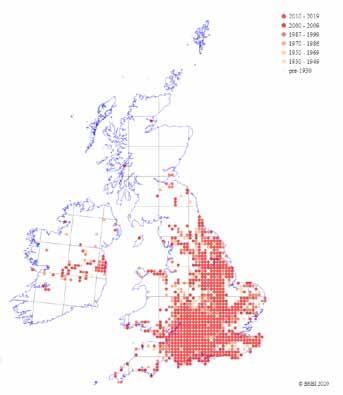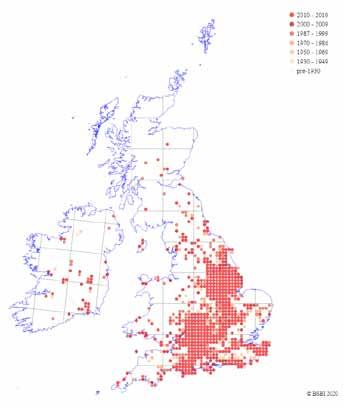
9 minute read
John Handley
Holy Trinity Church in Coalbrookdale: Bromopsis erectus and Brachypodium pinnatum
John Handley
Advertisement
After surveying a site, more often than not, I come away with a half-formed question, and I thought I’d share my findings after surveying the churchyard of Holy Trinity Church in Coalbrookdale, in the hope that somebody may be able to provide an answer to my question. I had spent the day working locally and thought I’d call into the Churchyard and make some records. It was a sunny end to an enjoyable day and I’d wanted to visit this churchyard after it came to my attention as the burial place of Abraham Darby IV and his wife Matilda, both notable individuals within Ironbridge. With a peal of ten bells, it is an imposing church set within the beautiful wooded valley of Coalbrookdale. As I approached the metal gate set within the wall to the east of the church I fell into conversation with the Churchwarden, Mrs Darlington. She was diligently cleaning a set of steep steps and graciously allowed me to enter the churchyard. I learned that she had woken that morning to the realisation that she would have been married in this Church 56 years ago, that very day. She explained that her husband wasn’t alive anymore; I later learned that there is a memorial to him within the churchyard. Mrs Darlington was born at the Wharf in Ironbridge and Holy Trinity Church has evidently played a significant role within her life. I saw her several times, in passing, over the next few days, each time she was engaged in conversation with various neighbours and appeared to have time for everyone. This led me to contemplate community and serving the communities in which we live or where we encounter them, such as online communities, which have recently become more significant within my own life, and I imagine for many others too.
I surveyed the churchyard and recorded 112 species, the two that were the most remarkable were Upright Brome Bromopsis erecta (syn. Bromus erectus) and Heath Falsebrome Brachypodium pinnatum (previously Tor-grass). This was the first time that I’d seen Upright Brome and after keying it through successfully I also collected a specimen which is currently in my press. There were a dozen plants distributed alongside a path in the southeast of the churchyard, all going to seed and thriving despite the shade provided by the canopy of Yew trees.
Bromopsis erecta – Upright Brome
Although not regarded as one of the rare Bromes within Shropshire, it is not a common species. The BRC (Biological Records Centre, 2020) comments that it is ‘a tufted winter-green perennial grass of dry, relatively infertile calcareous soils, growing in ungrazed or undergrazed chalk and limestone grasslands, where it often forms dense stands with Brachypodium pinnatum. It also occurs on calcareous sand dunes, roadside banks, quarry spoil and occasionally waste ground, but avoids wet or arable sites. It spreads by seed. Lowland.’ The recent Shropshire Flora (Lockton & Whild, 2015) states that it is an axiophyte occurring within meadows and limestone quarries (figure 1). ‘Usually in Species-rich calcareous grassland such as CG2 Avenula pubescens in Ballstone Quarry, Jones’s Rough and Windmill Hill; CG3 Bromopsis erecta at Ballstone Quarry, on the rock outcrops at Ippikin’s Rock, in Lea and Lilleshall quarries, on Moelydd, at Stokes’s Barn and the Foxholes; in CG7 Thymus polytrichus on limestone exposures at Presthope; MG1c Filipendula ulmaria on a hedgebank at the Speller and in MG5 Festuca rubra at Stretton Westwood and Treflach.
The Ecological Flora of the Shropshire Region (Sinker, et al., 1991) provokes my curiosity declaring that ‘the small hedged fields of Llynclys Hill and neighbouring parts of the Oswestry uplands are as rich as any limestone pastures in the Midlands or the Welsh Marches. One of their surprising, and perhaps significant, features is the virtual absence of the major calcicole grass species found on other parts of Britain. Upright brome is rare in the Oswestry district while tor-grass, crested hair-grass,
Figure 1. Distribution of Bromopsis erecta within Shropshire (BSBI, 2020).
meadow oat-grass and blue moor-grass are completely missing from the grasslands of this region. Red fescue and quaking-grass take their place, with spring sedge and glaucous sedge.’ It certainly seems to run out of steam when it gets to Shropshire (Figure 2).
Brachypodium pinnatum – Heath False-brome

Figure 2. Distribution of Bromopsis erecta within Britain and Ireland (BSBI, 2020).
Until recently, there were only two species of Brachypodium recognised amongst the native flora of Britain and Ireland: False Brome, B. sylvaticum, and Heath False-brome, B. pinnatum. In the second edition of Stace (1997), B. rupestre is mentioned in Other spp., as “reported in 1991 but requiring confirmation and close to B. pinnatum”. The third edition (2010) includes B. rupestre as a third native species. Rather confusingly Brachypodium rupestre has been assigned the vernacular name Tor-grass and the split recognises B. pinnatum as Heath False-brome. Brachypodium rupestre is native and often dominant in grassland on chalk and limestone. Whereas B. pinnatum is native in grassland, scrub, open woodland and marginal habitats, often on clay. The distribution of each species is currently unknown, since all records have previously been ascribed to B. pinnatum. Brachypodium pinnatum has flat leaves when fresh, with minute prickle-hairs (≤30µm) between and over the veins on the lower side (microscope recommended). The raceme is usually slightly pendent and the spikelets are usually hairy. B. rupestre has leaves usually inrolled even when fresh, without minute prickle-hairs between the veins on the lower side. The raceme is usually stiffly erect and spikelets are usually glabrous. In practice, distinguishing these taxa is relatively difficult as B. rupestre can have hairy spikelets and variable amounts of prickle hairs between the ribs, even within the same colony, (Stace, 2019). Tom Cope the author of the new BSBI Grasses Handbook (Cope & Gray, 2009) is sceptical about distinguishing these taxa at species level, saying that ‘there is general agreement that the morphological characters, both qualitative and quantitative, overlap to the point where they cease to be of much practical value’ concluding that ‘there is more work to determine whether a distinction is both practicable and useful.’ (Amphlett, 2011). Brachypodium pinnatum spreads mainly by means of extensive creeping rhizomes, and can form dense stands often creating a thick layer of persistent leaf litter. Within chalk grasslands that are renowned for their species-rich swards, and associated invertebrate faunas, it is often considered an invasive weed. It became more firmly established in these areas following changes in grazing practice and the advent of myxomatosis, sheep and rabbits having formerly held the grass in check. Although vegetatively vigorous, seed set is poor and variable, averaging around 20% at best. Where viable seed is produced it is shed from September onwards though some may overwinter on the plant. Seeds
Date Recorder Determiner Location GR Comment
1983 Blunt, A.G.
1990 Bingham, J.
2013-06-29 Evans, D.J. Trueman, I.C.;Benoit, P.M. Vane Coppice SJ674051 Roadbank.
Clee Hill SO601749 A few plants on the steep, southfacing slopes of old limestone workings.
Shrewsbury Cemetery SJ4811 Abundant in the cemetery.
2013-06-30 Duffell, M.S. Shrewsbury Cemetery
Table 1. Records of Brachypodium pinnatum within Shropshire. SJ488113 Abundant in the cemetery, growing through the limestone chippings.
germinate in spring and appear not to form a persistent seedbank (Cope & Gray, 2009). Within Shropshire it is regarded as a rare plant (Lockton & Whild, 2005), having only been recorded at three sites (table 1). I was fortunate to see it growing at Shrewsbury Cemetery in June 2019, doing remarkably well and occupying over a hundred square metres of the Cemetery. But I was very surprised to see it at Coalbrookdale ‘amongst and growing on several graves within short mown turf, 10 square metres.’ Although perhaps I shouldn’t have been, as this is less than a kilometre from where it was initially found by Godfrey Blunt in 1983.
The entry for Brachypodium pinnatum within the Ecological Flora (Sinker, et al., 1991) reiterates that a ‘curious feature of the limestone grasslands in this region is the rarity or absence of most of the characteristic species of most of the calcicolous grasses found in similar habitats elsewhere in the British Isles. Bromopsis erectus is on the edge of its range, becoming very rare in the Oswestry uplands; Brachypodium pinnatum only occurs as a casual here; Sesleria albicans has its main area of distribution well to the north. The most surprising gaps, however, are those in the ranges of Avenula pratensis and Koeleria micrantha, neither of which should be climatically excluded.’ The distribution map appears to support this statement (figure 3), with the distribution of both species conspicuously avoiding Shropshire. Back to that half-formed question that occurred after I’d finished recording the Churchyard. The records for Brachypodium pinnatum seem to show that limestone chippings are a common substrate for this species. Cemeteries and churchyards appear to offer this species a useful habitat. Why? The management within the cemetery at Shrewsbury and the churchyard in Coalbrookdale are different. How did it appear in the two burial grounds? Is it being carried, and potentially distributed, on mowers? Or possibly through limestone chippings on the graves? But the question that has emerged through writing this article is why is there such a conspicuous absence of calcicolous grasses on suitable geology within Shropshire?

Figure 3. The distribution of Brachypodium pinnatum s.l. within Britain and Ireland (BSBI, 2020).
References
Amphlett, A., 2011. A native population of Brachypodium pinnatum (Heath False-brome) in Banffshire (v.c.94), refound after 144 years. BSBI News, April, p. 17. Biological Records Centre, 2020. Bromopsis erecta. Available at: https://www.brc.ac.uk/plantatlas/plant/ bromopsis-erecta [Accessed 19th June 2020]. BSBI, 2020. BSBI Maps. Available at: https://bsbi.org/maps [Accessed 19th June 2020]. Cope, T. & Gray, A., 2009. Grasses of the British Isles. 1 ed. London: Botanical Society of the British Isles. Lockton, A. J. & Whild, S. J., 2005. Rare Plants of Shropshire. 3 ed. Shropshire: Shropshire Botanical Society. Lockton, A. J. & Whild, S. J., 2015. The Flora and Vegetation of Shropshire. 1 ed. Shrewsbury: Shropshire Botanical Society. Sinker, C. A., Packham, J. R., Trueman, I. C., Oswald, P. H., Perring, F. H., Prestwood, V. W., 1991. Ecological Fora of the Shropshire Region. 2 ed. Shrewsbury: Shropshire Wildlife Trust.
Stace, C., 1997. New Flora of the British Isles. 2 ed. Cambridge: Cambridge University Press. Stace, C., 2010. New Flora of the British Isles. 3 ed. Cambridge: Cambridge University Press. Stace, C., 2019. New Flora of the British Isles. 4 ed. Suffolk: C & M Floristics.
Addendum: I collected specimens of Brachypodium pinnatum from both of the sites, the cemetery at Shrewsbury and the churchyard at Coalbrookdale and sent them away to Michael Wilcox for verification but unfortunately neither were conclusive. Michael states that ongoing studies in Spain are trying to establish if these are two species, although Covid 19 has halted much of that work this year.








